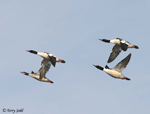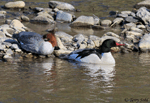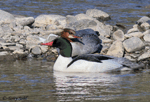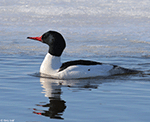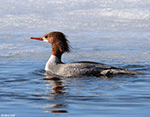Common Merganser
Mergus merganser
| Length: 25 inches | Wingspan: 35 inches | Seasonality: Migrant / Winter |
| ID Keys: White body with dark blackish-green head, black back. Female gray with rusty head. | ||
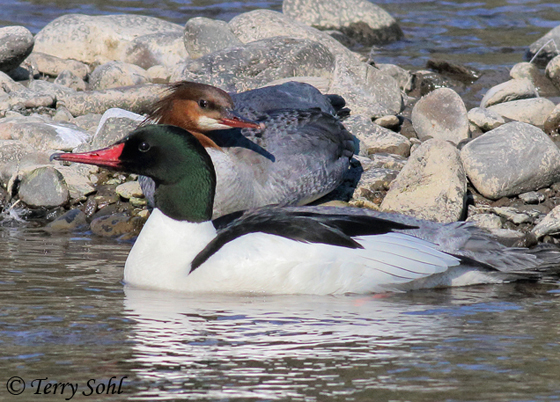 Common
Mergansers are a common migrant in South Dakota, and a common winter resident
along larger river systems in the state. They have also occasionally been
confirmed as breeders in the Black Hills. An expert diving fish-eater, they have
a large bill with serrations that assist them in grabbed onto slippery fish and
other prey. Common Mergansers are typically gregarious, foraging in small groups, although large flocks may form in winter below
large Missouri River reservoirs in the state. The species is also found in
Europe, where it is called a "Goosander".
Common
Mergansers are a common migrant in South Dakota, and a common winter resident
along larger river systems in the state. They have also occasionally been
confirmed as breeders in the Black Hills. An expert diving fish-eater, they have
a large bill with serrations that assist them in grabbed onto slippery fish and
other prey. Common Mergansers are typically gregarious, foraging in small groups, although large flocks may form in winter below
large Missouri River reservoirs in the state. The species is also found in
Europe, where it is called a "Goosander".
Habitat:
Strongly prefers freshwater, where it can be found on a variety of open water habitats.
Diet:
Mostly fish. Also crustaceans, amphibians, aquatic insects, and occasionally aquatic plants.
Behavior:
Forages by diving below the water's surface and swimming underwater, propelled by its feet. They can sometimes be seen swimming on the surface, peering underwater with their heads partially submerged, and then diving after prey underwater when it is spotted.
Nesting:
Rare breeder in South Dakota. Common Mergansers are cavity nesters, most frequently nesting in an old woodpecker cavity or other cavity in a tree. Much less frequently, they will nest in other types of cavities, including cavities in man-made structures, natural crevices on rocky ground, or even inside of a hollow log. At the nest site the female will scrape together natural material as a base (for example, the wood chips at the bottom of a tree cavity), and then typically line the bottom of the nest site with downy feathers. The female will lay between 6 and 16 eggs, and she alone incubates them. Incubation takes about 4 weeks. After all the young in a brood hatch, the female will lead the young to a nearby water body and tend to them, while the young gather their own food. Common Mergansers can also practice nest parasitism, laying the eggs in the nests of other merganser (or even other species).
Song:
Common Mergansers are typically quiet, but will make various calls in and around nesting sites, and when alarmed. including hoarse croaking and quacking-like calls.
- Click here to hear hoarse croaking calls of a Common Merganser1
- Click here to hear the calls of a Common Merganser in flight2
Migration:
Summers in Canada and extreme northern U.S., winters throughout much of the United States interior, and sometimes on protected bays along coastlines.
Interactive eBird Map:
Click here to access an interactive eBird map of Common Merganser sightings
Similar Species:
Other mergansers are the species most likely to be confused with a Common Merganser, particularly female merganser species.
- Red-Breasted Merganser - Red-breasted Mergansers are migrants in South Dakota, and typically less common than Common Mergansers. Males are more easily differentiated from Common Mergansers, as male Red-breasted Mergansers have finely barred sides that result in a gray appearance, and a rusty colored breast, and more complex black and white markings compared to the more basic, clearly demarcated white and dark patterns of a male Red-breasted Merganser. Both female Red-breasted Mergansers and female Common Mergansers have a grayish body with a rusty head and crest feathers, but the female Red-breasted Merganser is more uniformly brown on the body and breast, while the female Common Merganser has contrasting white on the breast, and a white chin spot.
- Hooded Merganser - Hooded Mergansers are a smaller species of merganser that migrates through the state, with some birds breeding here in the summer months. The smaller size and shorter bill differentiate it from Common Merganser for both males and females. Male Hooded Mergansers have a unique plumage unlikely to be confused with a Common Merganser. Female Hooded Mergansers are more brown overall than the grayish color on the body of a female Common Merganser.
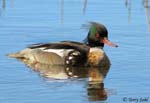 |
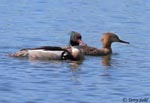 |
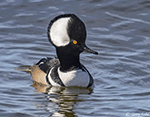 |
 |
| Red-breasted Merganser | Red-breasted Merganser | Hooded Merganser | Hooded Merganser |
Conservation Status:
Numbers appear to be stable throughout most of their North American range, as well as in their Eurasian range. They are found across an extremely broad geographic area, in both the Eastern and Western Hemispheres, and are common in parts of that range. The IUCN considers the Common Merganser to be a species of "Least Concern".
Further Information:
- USGS Patuxent Bird Identification InfoCenter, Common Merganser
- Audubon Guide - Common Merganser
- Whatbird.com: Common Merganser
Photo Information:
May 2014 - Kenai River in Alaska - Terry Sohl
Additional Photos:
Click on the image chips or text links below for additional, higher-resolution Common Merganser photos.
AAudio File Credits:
- 1Tero Linjama. Recorded in Finland on April 27th, 2008. Original recording and information available from xeno-canto.
- 2Francesco Sottile. Recorded in Italy on June 9th, 2019. Original recording and information available from xeno-canto.
| Click on the map below for a higher-resolution view |
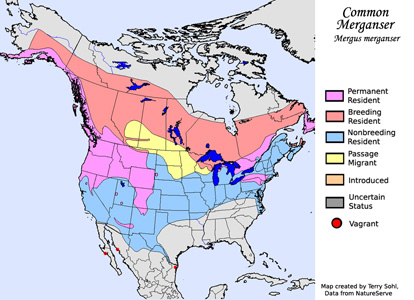 |
| South Dakota Status: Common migrant throughout the state. Common winter resident along the Missouri River, uncommon elsewhere where open water is available. There have been some recorded instances of breeding in the Black Hills. |
Additional Common Merganser Photos
Click for a higher-resolution version of these photos
